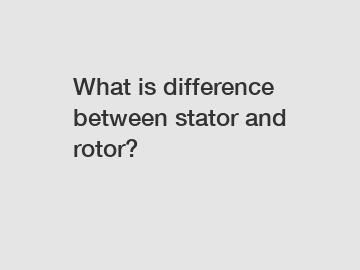What is difference between stator and rotor?
When it comes to understanding the inner workings of an electric motor, two fundamental components come to mind: the stator and the rotor. These vital elements play crucial roles in converting electrical energy into mechanical energy, making them the backbone of countless devices and machinery we encounter in our daily lives. In this blog post, we will dive into the depths of stators and rotors, unveiling their differences and shedding light on their intricate functions.
First and foremost, let's grasp the concept of a stator. Imagine it as the stationary part of a motor, which doesn't move or rotate. Typically, the stator comprises a core made of laminations, forming a cylindrical shape with slots or teeth. These slots accommodate insulated conductors that are coiled around them, known as stator windings. When electric current flows through these windings, they establish a magnetic field.
The rotor, on the other hand, is the moving component of the motor. Its primary purpose is to rotate within the magnetic field established by the stator, generating mechanical motion. Instead of windings, the rotor consists of conductive bars or wire loops, referred to as rotor windings, which are connected to a shaft. As electric current passes through the rotor windings, it interacts with the magnetic field produced by the stator, resulting in torque and rotational movement.

Now that we have a basic understanding of the stator and rotor, let's delve deeper into their differences. Their dissimilarity lies in their functionality and physical attributes. The stator is primarily responsible for initiating the induction of a magnetic field. It serves as the foundation that produces a constant magnetic field when powered. This immobile component houses the stator windings, which act as electromagnets when excited by an electrical current. The stator's main role is to create a rotating magnetic field, which then interacts with the rotor to induce motion.
On the contrary, the rotor is designed to respond to the generated magnetic field by the stator. As the stator's magnetic field rotates, it induces an electrical current in the rotor windings through electromagnetic induction. This current, in turn, generates an opposing magnetic field in the rotor. The interaction between the two fields creates a force known as torque, propelling the rotor into motion. Consequently, the rotor's primary task is to convert the electrical energy obtained from the stator into mechanical power.
Beyond their functional disparities, the stator and rotor also differ in physical structure and characteristics. The stator remains fixed and is typically built using a ferromagnetic material as its core. This material allows for efficient magnetic flux generation and reduces energy losses. Additionally, the stator core incorporates slots that hold the stator windings, ensuring they are properly positioned and secured. The winding wire's high electric conductivity, combined with the stator's insulation, promotes efficient energy conversion.
On the other hand, the rotor is crafted differently to accommodate its rotational nature. It often employs conductive materials like aluminum or copper, allowing for easy flow of electrical currents. Furthermore, the rotor bars are connected to an iron core, enhancing its magnetic field response to the stator. In some motors, the rotor may also employ permanent magnets instead of coil windings, yielding increased efficiency. These magnets possess their own magnetic field, eliminating the need for current induction in the rotor.
In conclusion, although the stator and rotor are integral components of electric motors, their functions and physical attributes set them apart. The stator stands as the stationary core responsible for generating a rotating magnetic field, triggering the rotor's motion. Meanwhile, the rotor acts as the moving component, converting the magnetic field generated by the stator into mechanical power. Understanding these disparities helps us appreciate the intricate interplay between the stator and rotor, enabling us to comprehend the fantastic machines that shape our modern world.
If you want to learn more, please visit our website Bus motor core, stator and rotor manufacturer, stator and rotor manufacturer.

Comments